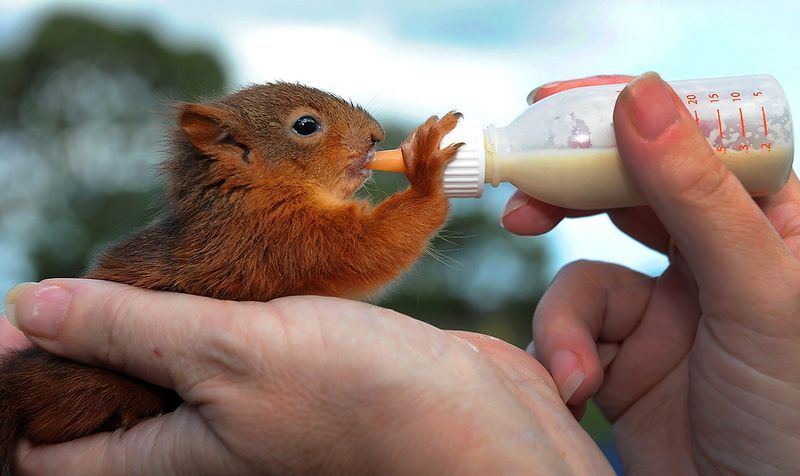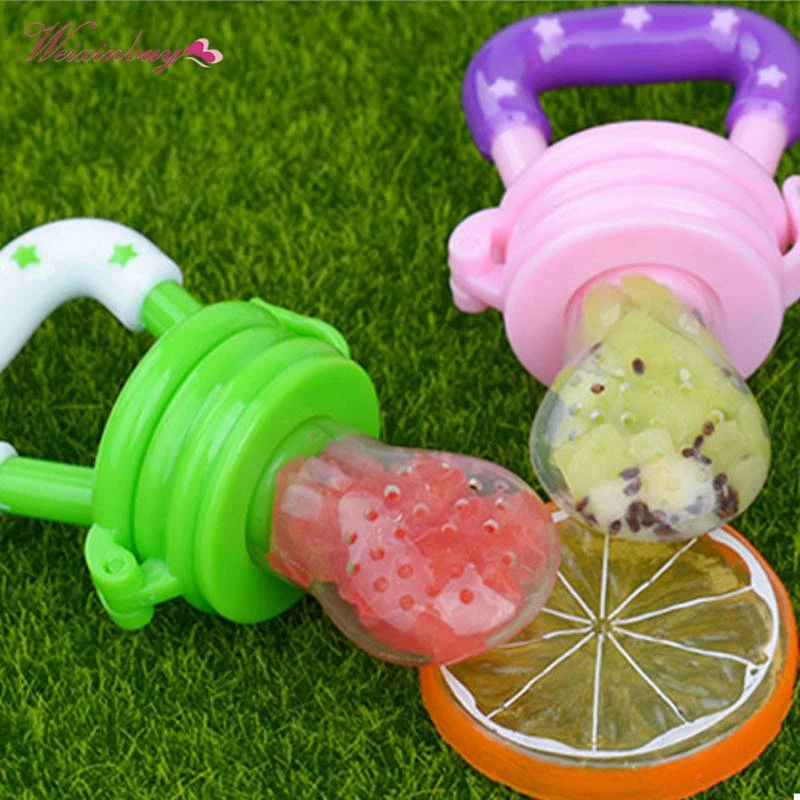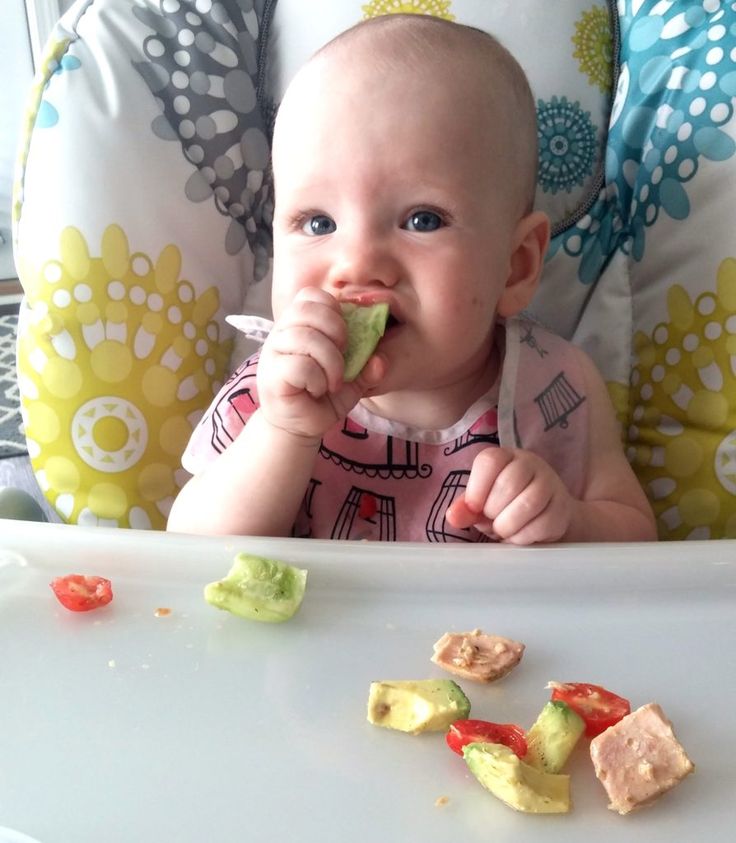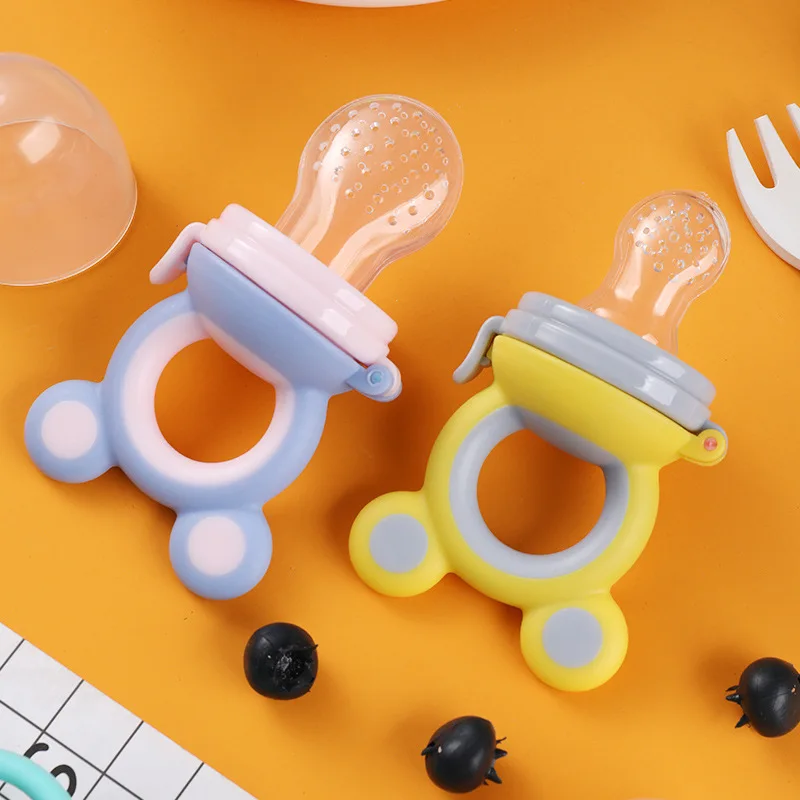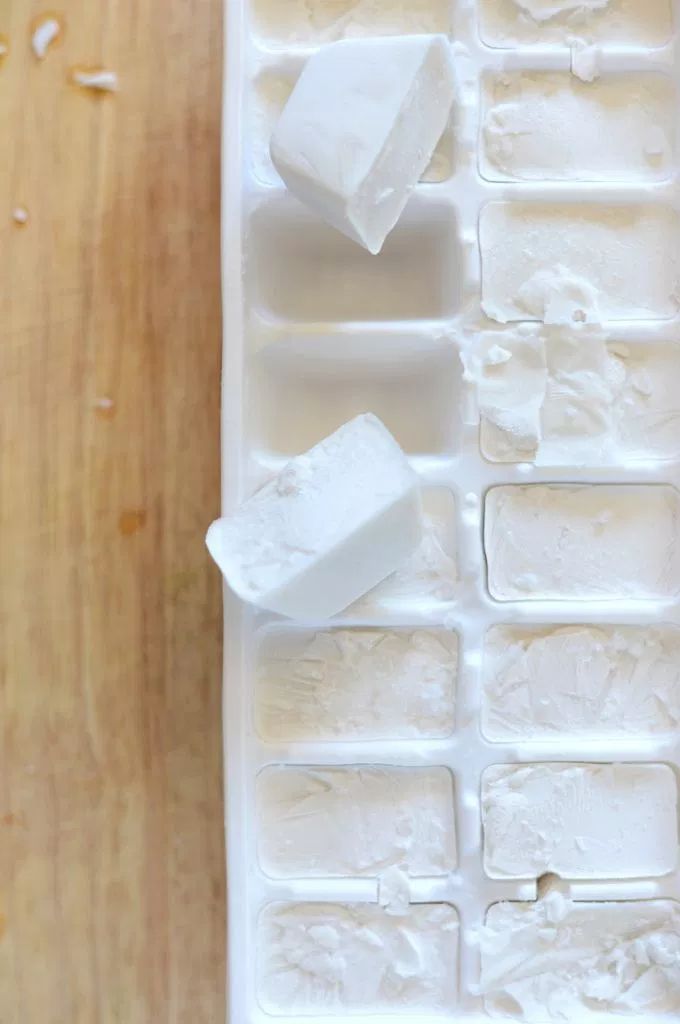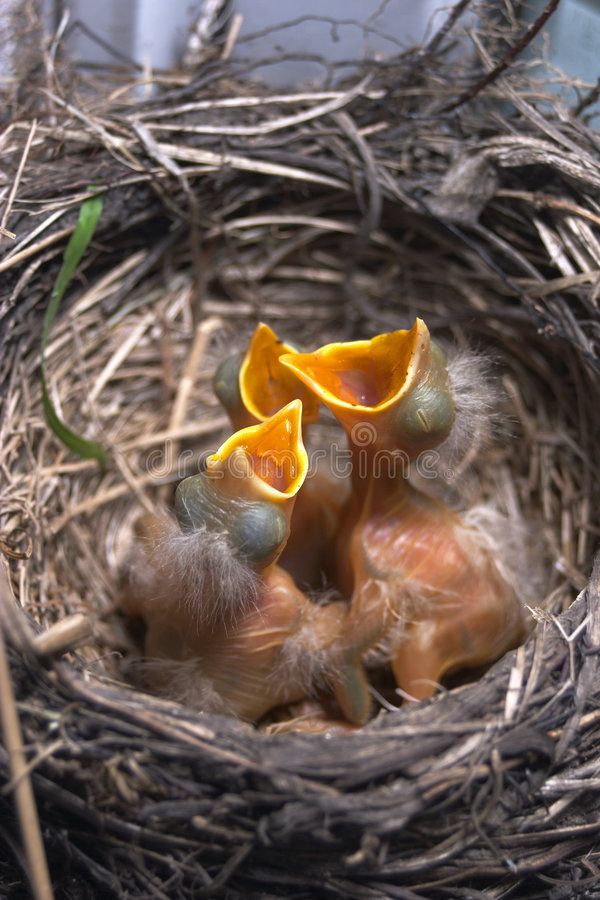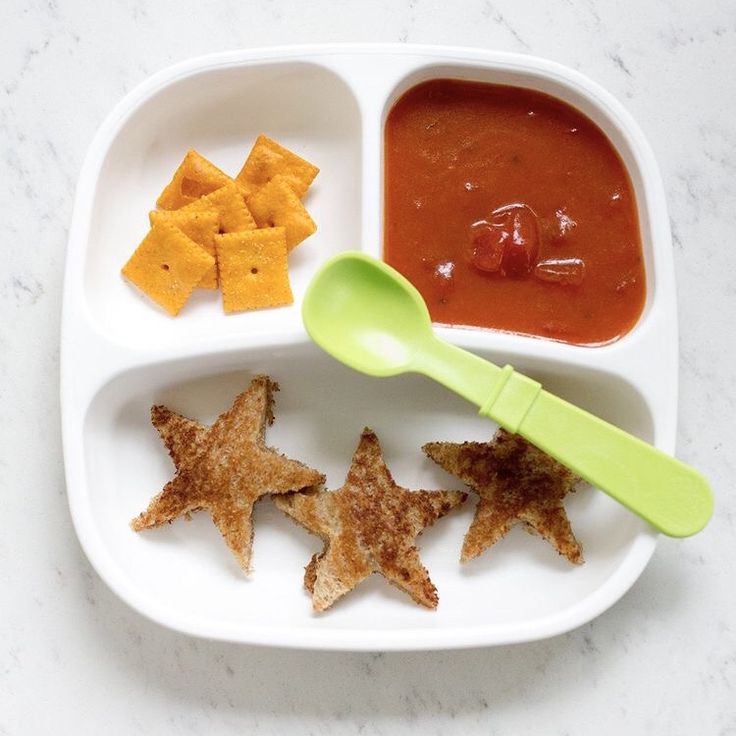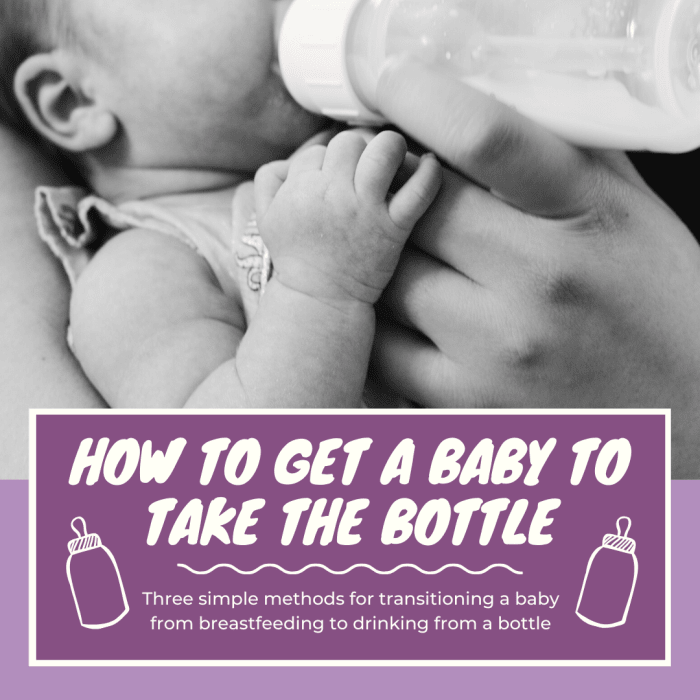Baby squirrel feeding times
Squirrel Feeding Amounts | Mysite
The first 12 to 24 hours the baby should be fed only an electrolyte hydration formula, such as Pedialyte for infants. Do not start feeding a baby until it is first warm, well hydrated, and has started to eliminate normally. Reference the links at the bottom of this page for more information on these topics.
If the baby has never had formula or is changing to a new brand, you must slowly introduce it over several feedings. Formula is never exactly like, or as good as, mother's natural milk. The baby's gastro- intestinal tract (gut) needs time to adjust to man-made formulas through slow introduction from the hydration fluid to full strength formula. Reference the section entitled, “Transitioning to Formula” at the bottom of the Feeding Technique page (Link at bottom).
Figuring Out How Much to Feed
The ideal amount to feed the baby at each feeding is up to 5% of its body weight at an interval that closely matches the frequency the mother would feed her young in the wild. Below is a rough guide to the amount and schedule for feeding a baby based on its approximate age and size.
It is highly recommended that you purchase a gram scale to reduce overfeeding. Baby squirrels are notorious hogs and will happily overeat. Overeating may result in life threatening diarrhea and easy predation by cats, hawks and other menaces that prefer chubby slow moving prey. Reference the link entitled, “Feeding complications” for more information.
If you don’t have a method of weighing the baby and are unsure of its age, you can roughly estimate it by comparing your squirrel to the ones pictured on the “How to determine the age of a baby squirrel” article (link to the right) available on the Chris’s Squirrels & More website.
The maximum amount should be no more than 5% in cc’s for the squirrel’s body weight in grams.
For example, if the squirrel weighs 100 grams (approximately 3.5 ounces), then 5% is 5 grams (.17 ounces) which translates to 5 cc (cubic centimeters) or ml (milliliter) or (1 tsp) of formula.
Table 1: Feeding Amounts by Weight
Figuring Out How Frequently to Feed
How often you feed a baby squirrel the amounts listed above depends on their age. Use Table 2 below to figure out how often to feed your babies based on their ages.
Here's an example based on Table 1 below:
A squirrel weighing 100 grams should be fed every 4 to 5 hours (reference Table 1 for squirrels weighing 120-160 grams) . The amount fed should be no more than of 5 cc (1/2 tsp*) of formula (reference Table 2 for amounts based on 100 grams of weight.
A note about frequency: It is ok to feed plus or minus 1/2 hour to accommodate scheduling for squirrels under 6 weeks. Older squirrels can be fed plus or minus 1 hour.
*Reference the Online Conversion Calculators if converting grams (weight) or cc’s (volume) to other measuring systems.
Table 2: Feeding Frequency by Age and Weight
Keeping Track of Feedings
It’s important that the baby doesn't get too much or too little formula to eat and that you know when it last eliminated (and if the product was normal - No blood in urine, loose or foul smelling stool!
Lack of normal appetite and abnormal bodily functions are important queues indicating a problem requiring immediate attention.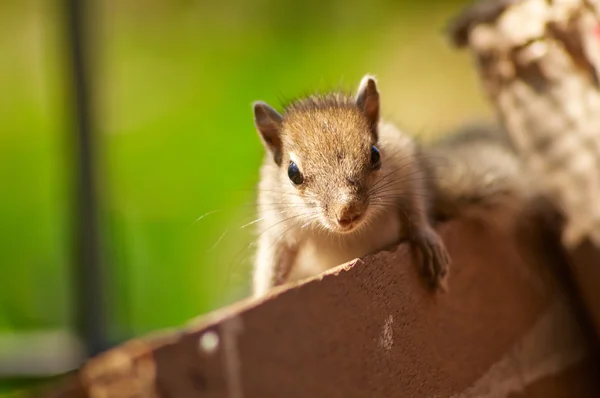
Keeping track can be especially hard when you have more than one care giver or multiple squirrels.
Our advice is, Write it down! Use our recommended daily care chart below.
If you are caring for multiple squirrels you might notice that it can be hard to tell who is who.
Consider using a temporary identification method such as a non-toxic nail polish or permanent Sharpie marker on an
ear or the tummy. You may need to reapply every few days.
If the squirrels are furred and you only have a small number , another option is to clip a small notch of fur from the tail at different locations.
Tail fur only replaces itself once a year, so don’t go crazy with this by trimming a large quantity of fur. Squirrels use their tails to communicate, for warmth, and balance.
Top Tips for the Safe Feeding of Squirrels
There are many things to consider for the proper feeding of baby squirrels, but here is a list of the top things you should know:
-
Do not add vitamins or minerals to any commercially prepared milk replacement product as they are already nutritionally complete.
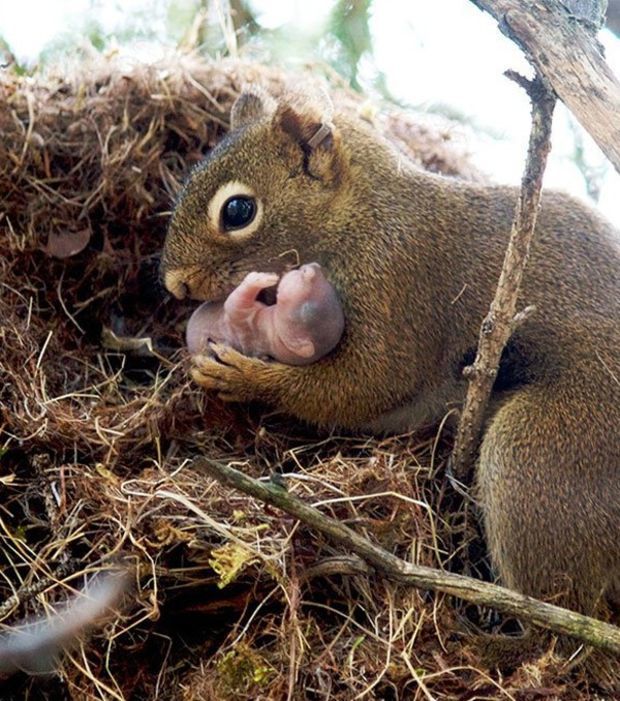
-
Do not allow the baby to eat more than the recommended amount or frequency.
-
Never feed baby squirrels cow's milk, fruit juice, Tang, Sunny D or any other sweet drink! Really, Never!
-
Never attempt to feed a cold baby! Baby should feel warm in your hands. Feeding a cold baby will kill it because it cannot digest the formula when cold.
-
Never feed a baby on its back or too fast. Use a 1cc syringe on small babies to control the feed rate. Baby squirrels easily aspirate and choke.
-
Always stimulate the baby to urinate after feeding! An ‘eyes closed baby’ cannot eliminate without stimulation and will suffer a painful death without help.
-
Normal formula fed baby squirrel feces ranges from yellow to dark golden colored and is well formed like small seeds. If the stool becomes loose, smelly, watery, white or very pale then cut back on the concentration of formula or provide pedialyte for a few feedings until the feces is normal again.
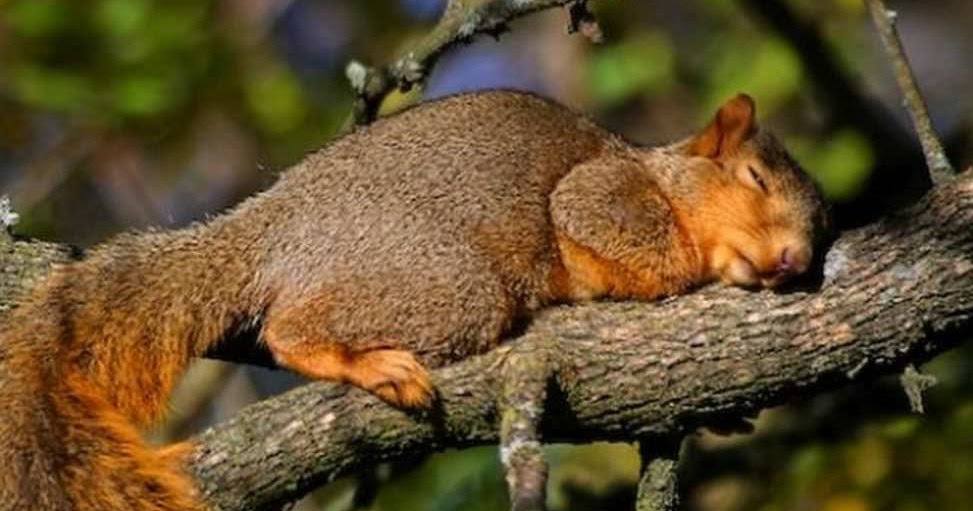 Adding a small amount of acidophilus or yogurt to the formula helps to keep the baby regular.
Adding a small amount of acidophilus or yogurt to the formula helps to keep the baby regular.
More Resources
Feeding Techniques
Learn how to properly and safely prepare food for and then feed your baby squirrel.
Feeding
Tools
Get recommendations for the best tools for the safe and proper feeding of baby squirrels.
Formula
Options
Get recommendations on the best formula to buy or make at home for baby squirrels.
Feeding Complications
Make yourself of what could go wrong during feeding, what signs to look for, and how to prevent it.
Warming Baby Squirrels
Before you feed, make sure your baby squirrel is safely warmed using our gentle and simple methods.
Treating Dehydration
Learn the signs of dehydration in baby squirrels and how to treat them.
Potty
Stimulation
Learn how to safely stimulate your baby squirrel until they are able to potty themselves.
Squirrel
Board
Have more questions? Ask the Squirrel Board, a forum managed by rehabbers and experts.
Baby Squirrel Care - Formula Feeding
Once the baby squirrel is warm and has had some hydration fluid, you are ready to start feeding. What do baby squirrels eat? Formula, also called “milk replacer.”
Formula Recommendations for Different Ages
- Pinkies less than 10 days old: Homemade Goat Milk Formula for 10 days, then switch to either Esbilac Puppy Milk powder, or Fox Valley 32/40, then switch to Fox Valley 20/50 by 4 weeks old.
- 10 days old to 2 weeks old: HGMF or Esbilac until you receive your Fox Valley 32/40, then switch to Fox Valley 20/50
- 3 weeks and older: HGMF or Esbilac until you receive your Fox Valley 20/50
HGMF works the BEST for tiny pinkies in our experience.
Homemade Goat Milk Formula Plus (HGMF+):
- 3 tablespoons goat milk
- 3 tablespoons plain yogurt
- 2 tablespoons heavy cream
- ½ egg yolk
You can buy goat milk at most grocery stores.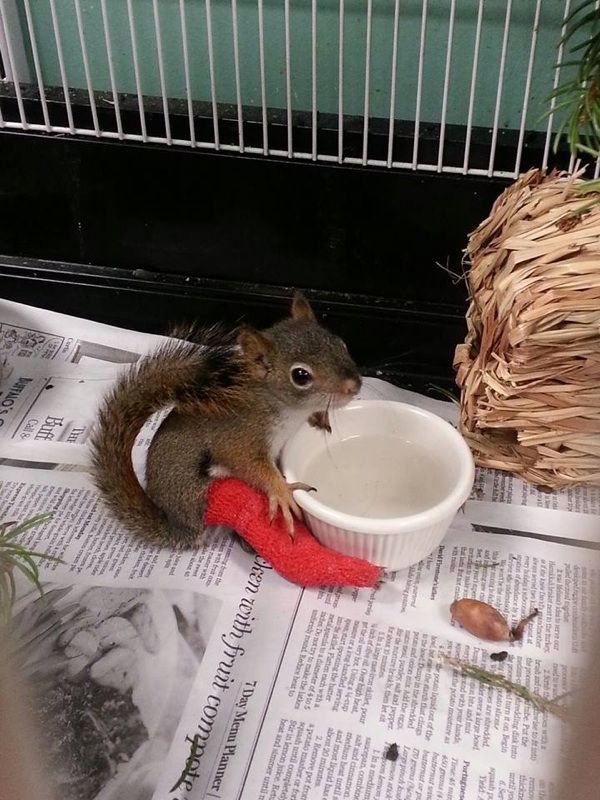 If you can't find fresh goat milk, you can use canned or powdered. Note: Canned or powdered milk must be mixed with water FIRST according to label directions. Do not use HGMF+ for more than two weeks at a time as it is not fully fortified with vitamins/minerals. If you can't find goat milk, double the yogurt (6 tablespoons).
If you can't find fresh goat milk, you can use canned or powdered. Note: Canned or powdered milk must be mixed with water FIRST according to label directions. Do not use HGMF+ for more than two weeks at a time as it is not fully fortified with vitamins/minerals. If you can't find goat milk, double the yogurt (6 tablespoons).
Be alert for bloating, diarrhea or constipation, and take immediate action. See page 5, "Common Problems."
Make sure formula is very, very warm. Baby squirrels will not drink enough formula if it is only slightly warm....they will starve to death!
Mixing, Feeding and Storing Formula
- When using a powdered formula, mix with very warm water. Allow the formula to sit for a while (or overnight) in the fridge so it dissolves.
- Before each feeding, stir the formula and draw up enough syringes of cold formula for the feeding.
- Microwave a coffee mug of water until it is hot (but not boiling).
 Then dunk the filled syringes in the hot water. They will take around 30 to 60 seconds to heat up.
Then dunk the filled syringes in the hot water. They will take around 30 to 60 seconds to heat up. - Take one syringe out, tilt it to mix the formula within the syringe, and test it on your wrist before feeding (should be VERY warm).
- If the formula in your syringe gets too cool while feeding, re-dunk it and pull out another syringe.
- Discard made-up formula after 24 hours.
7% Feeding Rule:
Weigh the baby on a scale in GRAMS; multiply that number by 7% (.07) and that will be the number of cc's (or ml's) to feed per feeding. You may need to start with smaller feedings at first, and work up to 7% after a few feedings, especially for emaciated babies.
Do not overfeed or increase feeding amounts too quickly! Baby squirrels will overeat if you let them and get diarrhea or bloating, which can be fatal. Weigh the baby every day at the same time to determine if they are gaining or losing weight and adjust the formula amount as needed.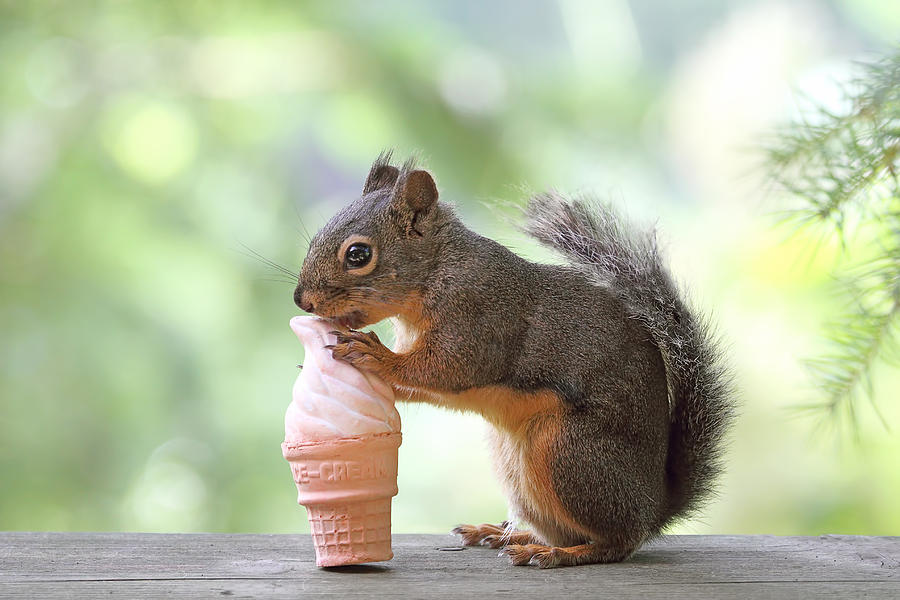
EXAMPLE:
Squirrel weighs 50 grams
50 x 7% = 3.5 (Using a calculator, it's 50 x .07 = 3.5)
So you feed 3.5 cc's per feeding
Potty Time
A baby squirrel less than 5 weeks old will need to be stimulated to poop and pee. Use a warm, wet cotton ball, Q-tip, the corner of a Kleenex, or your finger, and flick lightly across the genital area. Some babies may need stimulation before and after feeding. A few may eat better if you potty them in the middle of a feeding.
NOTE: Baby squirrels need lots of attention and affection, especially if he has no siblings. This will not hinder the release process in any way. Squirrels bond strongly with their human caretakers, but they do not "imprint" on humans like other wildlife. When it's time for release, their wild instincts will kick in just fine.
Don’t use cheap syringes that stick; use quality o-ring syringes and go slow to avoid aspiration!
PRINT THIS GUIDE
What and how to feed street squirrels?
What do squirrels eat and not eat?
Let's not talk about domestic squirrels, which are fed in such a way that people can envy.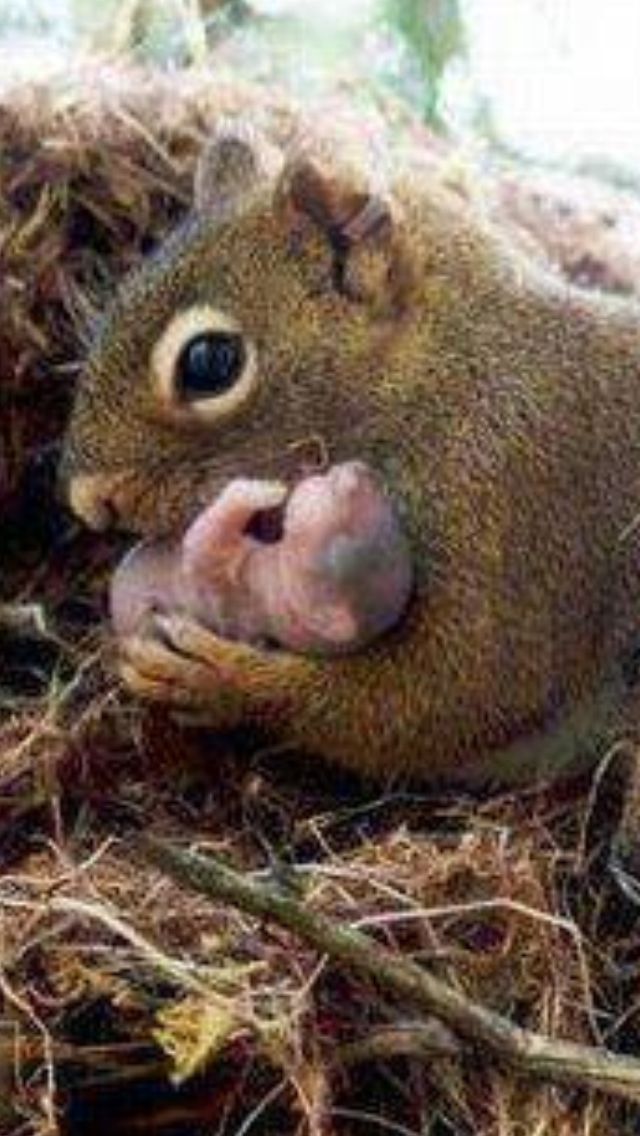 It will be about the city barefoot, which is not combed, washed and not taught manners.
It will be about the city barefoot, which is not combed, washed and not taught manners.
Squirrels, like rats, are omnivores and are also predators. They visit garbage dumps and garbage cans regularly. When I read that street squirrels cannot be fed chips, cheese, sausage and other foods from our table, I understand that the writer is idealizing the life of a squirrel. In fact, squirrels eat everything they can eat to survive. And in the winter, they will eat your healthy nut, and then gorge themselves on French fries thrown in the garbage. I often cannot catch a dog with a piece of stinking stuff found in the forest. So feed whatever you want. But! Don't feed, feed. Little by little, and not like a grandmother of grandchildren. In the wild, it is not food that causes premature death, but cold, hunger, disease, worms, predators, and gang warfare. The hungriest time is the end of winter, early spring. Lack of food in winter, as well as infectious diseases, kill up to 85% of young squirrels.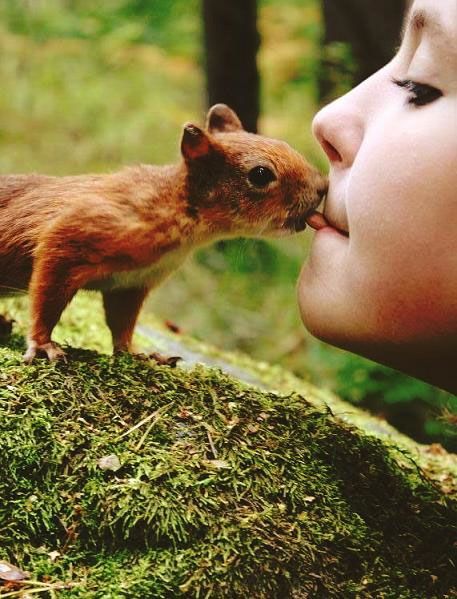
Now about what squirrels love.
Fruit.
Squirrels will happily harvest pears, grapes, apples, kiwis, avocados, peaches, nectarines, figs, plums, mangoes and citrus fruits. They eat any berries they can get their hands on, such as strawberries, blackberries, blueberries, raspberries, mulberries, and more. Squirrels are very fond of bananas, watermelons, melons and cherries! The benefit of eating fruit for squirrels is that it gives them enough glucose.
Dried fruits are a great treat for squirrels!
Vegetables.
Squirrels love vegetables to the delight of gardeners. If they stumble upon some leafy greens like lettuce, chard, kale, spinach, or arugula, they are sure to munch on them. Proteins will not disregard tomatoes, radishes, corn, pumpkin, beans, corn, peas, root vegetables, okra, eggplant, Brussels sprouts, carrots, broccoli, cabbage, asparagus, celery, cauliflower, leeks.
Flakes
Many squirrels are fed flakes. Squirrels naturally love the grains and nuts found in most cereals. The main advantage of many grains is that they tend to contain sugar, which gives the protein a much-needed energy boost during the winter. A lot of sweets, of course, will not provide the squirrel with a healthy lifestyle for many years, but it is better for the squirrel to die of happiness than of hunger.
Cheese
Squirrels won't encounter cheese in their natural environment, but thanks to our leftover picnics, they discovered this delicacy. They love him! Bits of cheddar, swiss, mozzarella, Russian and oltermani they will eat right away. They won't even hide. They will not pass by pizza and burger either. A good piece of cheese can give a squirrel extra fat for comfort during the winter months.
Nuts
Squirrels are fanatical about nuts. Hazelnut reproduces with the help of squirrels. The fact is that the squirrel hides nuts all over the area. Only her memory is short, and she simply forgets about them. As a result, in the spring the nuts germinate. Squirrels enthusiastically collect and eat pecans, walnuts, hazelnuts, almonds, pistachios, acorns, cashew nuts, chestnuts, hickory nuts, pine cone pine nuts, and macadamia nuts. Nuts are the optimal source of fat and protein for all types of squirrels. On the Internet, you can read about the dangers of almonds for squirrels. This assertion has a basis. But! Only if it is very hard to feed her with almonds, and especially in winter, when she is hungry. A couple of nuts will not bring her much harm. Where almonds grow, the squirrel is more tolerant to it and can eat more. In any case, it is better not to do this in the Russian expanses. Almonds are to squirrels like alcohol is to non-drinkers.
Hazelnut reproduces with the help of squirrels. The fact is that the squirrel hides nuts all over the area. Only her memory is short, and she simply forgets about them. As a result, in the spring the nuts germinate. Squirrels enthusiastically collect and eat pecans, walnuts, hazelnuts, almonds, pistachios, acorns, cashew nuts, chestnuts, hickory nuts, pine cone pine nuts, and macadamia nuts. Nuts are the optimal source of fat and protein for all types of squirrels. On the Internet, you can read about the dangers of almonds for squirrels. This assertion has a basis. But! Only if it is very hard to feed her with almonds, and especially in winter, when she is hungry. A couple of nuts will not bring her much harm. Where almonds grow, the squirrel is more tolerant to it and can eat more. In any case, it is better not to do this in the Russian expanses. Almonds are to squirrels like alcohol is to non-drinkers.
Bird food
Squirrel loves bird feeders. There are tons of videos on the net about how a squirrel tries to climb into the feeder.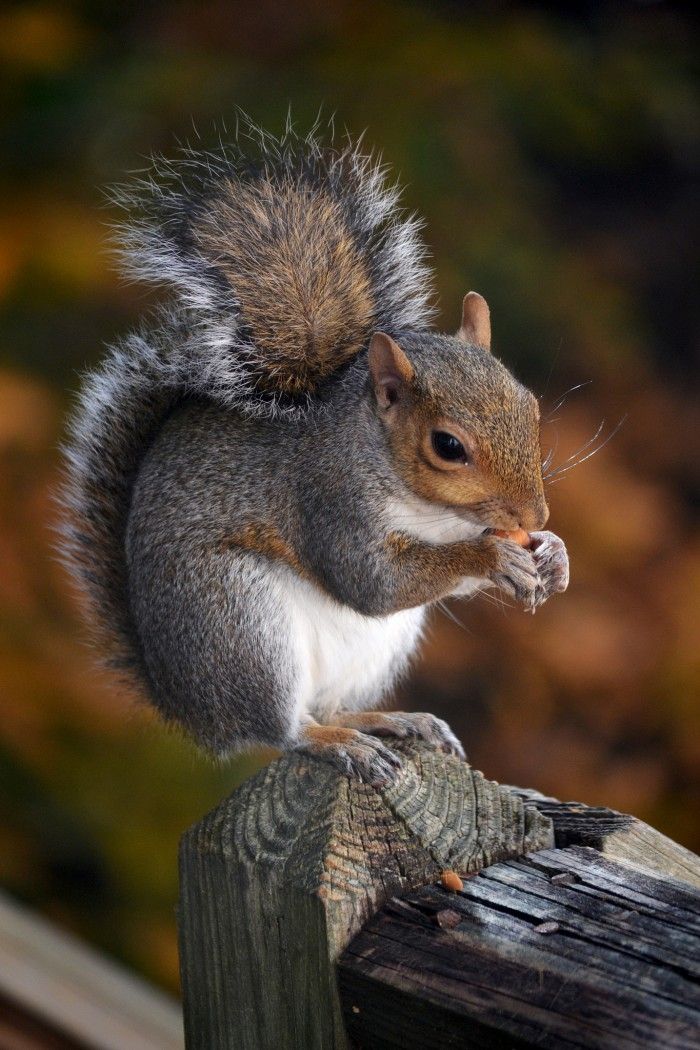 From bird food, she loves everything! Corn, seeds, wheat, millet. Even millet, which is eaten only by chickens, she will eat and not wince.
From bird food, she loves everything! Corn, seeds, wheat, millet. Even millet, which is eaten only by chickens, she will eat and not wince.
Insects
If fruit and nuts are not available, the squirrel will hunt for small insects to meet its protein requirement. Their diet includes caterpillars, grubs, winged beetles, grasshoppers, locusts, wounded butterflies and crickets.
Mushrooms
Squirrels are foragers and love mushrooms. She will not eat a mushroom that is poisonous to her, as a person can do. Squirrels can feed on lichen growing on the bark of many, especially mature trees. But in urban environments, they will prefer other food. Trying to treat a squirrel with mushrooms rarely brings results.
Eggs
This is a very nutritious prey. Finding them for a squirrel is a special happiness. To get bird masonry out of a hollow, to steal an egg from a chicken coop - this is the ultimate of her dreams. The squirrel will not miss the chance to take the chicks out of the hollow or nest or to grab the fallen pilot on the ground.
The squirrel will not miss the chance to take the chicks out of the hollow or nest or to grab the fallen pilot on the ground.
Plant Material
Squirrels will dig up roots, eat young leaves, fresh grass, plant stems. They tend to feed on the most tender and young stems and branches of plants, soft twigs and bark. They love sunflower, pumpkin, safflower, poppy seeds, pine buds, spruce, fir, larch seeds. Swallows will gladly eat your precious poppy flowers, hibiscus flowers, your passion flower petals and plant bulbs.
You won't be able to feed them grass or hay like a cow or a horse. Flowers in your hands, they will not appreciate either.
Dog and cat food
Squirrels are omnivorous and easily steal dog and cat food near private homes. A hungry squirrel can be so bold in experiments that he will even eat wet cat food or canned dog food, although this is not his passion at all.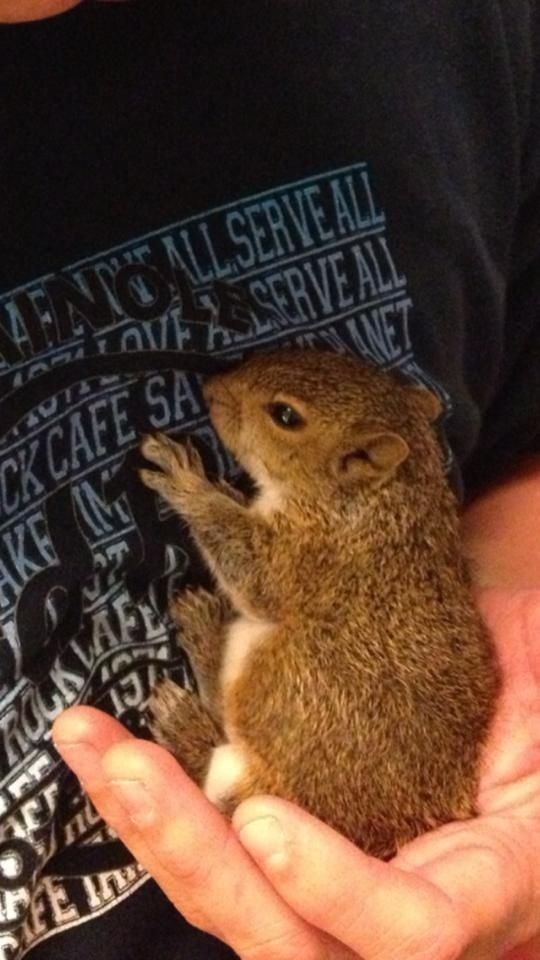
Waste and more waste
The next time you take out the trash or leave the remains of your picnic in the woods, know that a hungry squirrel is sure to find them. Will digest frozen pieces of birthday cake or sandwich crusts. Proteins do a great job of recycling and composting our sometimes excessive food waste. And such a service is harmful to animals in every way. The animal is out of the habit of looking for food in a natural way. If a squirrel only eats in a trash can, regular fried sausages, marshmallow buns and chocolates will painfully drive the poor guy to his grave. That's why I said that a slice of french fries or cheese in the woods could save a squirrel's life. A slice, not a bag of waste from the master's table.
When I overfed my dog with macadamia nuts, I realized that there is no limit to idiocy. After all, the dog asked so and was ready to carry out any commands. Even the poem was ready to tell. It ended with colic and a veterinarian. A veterinarian will not come to a squirrel with colic.
A veterinarian will not come to a squirrel with colic.
What doesn't a squirrel love?
Quite a bit. Raw onions, garlic, peppers and similar, harsh herbs and spices. She also hates things that cannot be eaten.
What is not advisable to give a squirrel?
Almonds, salted nuts, dairy products, chocolate, confectionery. Not desirable - does not mean impossible. It is not prohibited by law, and the squirrel will not die in front of everyone with a cry of “Oh Kolya, Kolya, how could you?”. You just need to remember that unnatural products are already found everywhere in the city.
Do you feed squirrels in parks or in your backyard?
Animals are funny, mobile and very popular with children and adults. I really want to feed from my hand and have time to stroke. A person at the moment of communication with an animal believes that stroking the head and back is a pleasure.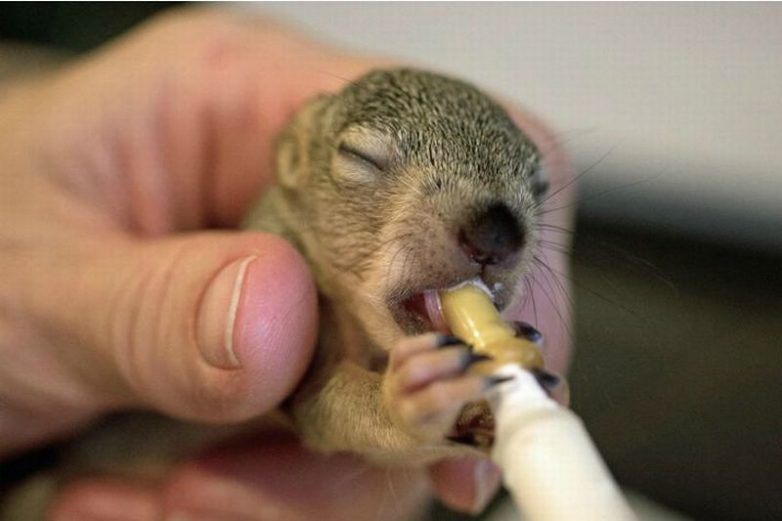 We do it with such love! Yes, it delivers, but only to a person. The animal is a boorish and selfish creature. And do not try to endow him with feelings of shame, love, care and gratitude. No, of course you can create such an illusion for yourself. But it is desirable to endow small and toothless creatures with these features. The larger the animal, the more you need to restrain yourself in the desire to feed it from your hand. But the squirrel is so small and cute. Can such an animal be evil? Maybe! And this is the basis of survival in the wild. The animal must be careful not to let itself be touched. In addition, in search of food, they arrange quite violent fights. They have no delicacy, and intelligent squirrels die in nests, saying to their brothers and sisters: "Thank you, I'm not hungry, take my nut!" Of course, if you feed a squirrel for many months, then it gets used to you and does not see a threat. You can take a risk and stroke. But still take the risk! A wild animal will never become a domestic animal.
We do it with such love! Yes, it delivers, but only to a person. The animal is a boorish and selfish creature. And do not try to endow him with feelings of shame, love, care and gratitude. No, of course you can create such an illusion for yourself. But it is desirable to endow small and toothless creatures with these features. The larger the animal, the more you need to restrain yourself in the desire to feed it from your hand. But the squirrel is so small and cute. Can such an animal be evil? Maybe! And this is the basis of survival in the wild. The animal must be careful not to let itself be touched. In addition, in search of food, they arrange quite violent fights. They have no delicacy, and intelligent squirrels die in nests, saying to their brothers and sisters: "Thank you, I'm not hungry, take my nut!" Of course, if you feed a squirrel for many months, then it gets used to you and does not see a threat. You can take a risk and stroke. But still take the risk! A wild animal will never become a domestic animal.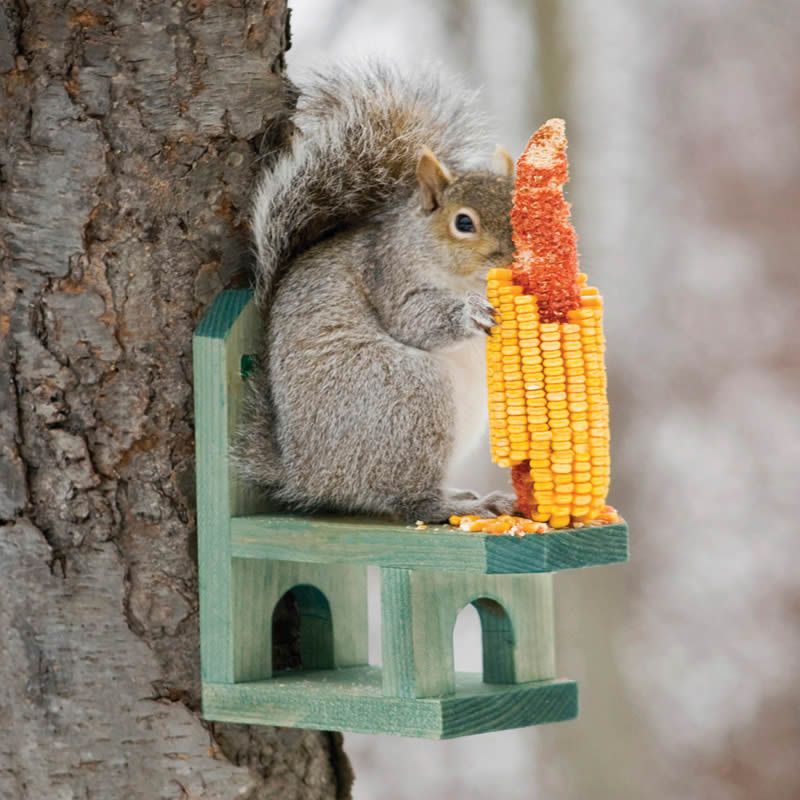 It is enough that in a neighboring yard, a person at the time of feeding will click her on the nose. There are many inadequate people and one such inadequate is enough to erase the established relationships. He clicked, and you, for your own nut, were bitten. Now about the squirrel bite! I really liked how they reassured a girl bitten by a squirrel on one forum: - “It's okay, go to bed, everything will be fine :) Good luck!” Russian people are unique. He does not believe in condoms (especially in the USSR), he does not believe in viruses, rabies, etc. He doesn't believe in death either. And after the bite, he looks at the statistics of rabies.
It is enough that in a neighboring yard, a person at the time of feeding will click her on the nose. There are many inadequate people and one such inadequate is enough to erase the established relationships. He clicked, and you, for your own nut, were bitten. Now about the squirrel bite! I really liked how they reassured a girl bitten by a squirrel on one forum: - “It's okay, go to bed, everything will be fine :) Good luck!” Russian people are unique. He does not believe in condoms (especially in the USSR), he does not believe in viruses, rabies, etc. He doesn't believe in death either. And after the bite, he looks at the statistics of rabies.
Squirrel Food
If there are few rabid squirrels, then you can take a chance and not go to the doctor. Logical and desperate! In my understanding, feeding a squirrel from your hand is like feeding a homeless person in the transition. Giving him money or food is debatable. The bum is not as playful and funny as the squirrel. Yes, I chose this life. But putting a nut in his mouth with your hands smacks of madness. And the presence of diseases, and incurable ones, in all the homeless, should not be ruled out. That is why the question is: “Is it worth the pleasure of scratching the squirrel dome of a rabies vaccination, going to the doctor, or self-confident expectation of a lethal outcome?” When squirrels gather a lot, they enter the courage and competition for food. Especially in winter! At such times they are especially aggressive. And do not be surprised when they first jump on your head like baboons, and then bite your manicure right down to the cuticle. Proteins in nature suffer from many dangerous diseases, one of the most common is tularemia. wikipedia.org/wiki/Tularemia". They almost all have worms and mites.
Yes, I chose this life. But putting a nut in his mouth with your hands smacks of madness. And the presence of diseases, and incurable ones, in all the homeless, should not be ruled out. That is why the question is: “Is it worth the pleasure of scratching the squirrel dome of a rabies vaccination, going to the doctor, or self-confident expectation of a lethal outcome?” When squirrels gather a lot, they enter the courage and competition for food. Especially in winter! At such times they are especially aggressive. And do not be surprised when they first jump on your head like baboons, and then bite your manicure right down to the cuticle. Proteins in nature suffer from many dangerous diseases, one of the most common is tularemia. wikipedia.org/wiki/Tularemia". They almost all have worms and mites.
Take care of your health! Restrain impulses of love and cuteness! Watch, feed, take pictures, laugh and be surprised when you look at these pranksters. Create squirrel rides out of boxes, plastic pipes and ropes. They love these games. You don't have to touch nature to enjoy nature!
They love these games. You don't have to touch nature to enjoy nature!
Squirrel
A fur-bearing animal that leads an arboreal lifestyle. The common squirrel is distributed throughout almost the entire territory of Eurasia.
Squirrels are cute but wild animals. Not every animal can become so tame that you can safely let it out around the room and even pick it up. Adults picked up from the street, as a rule, remain wild, never getting used to human care. A rescued baby that has fallen out of the nest can become a true friend for you, as it will get used to you from an early age.
By picking up a squirrel or an adult squirrel, you let another family member into your house and thereby take responsibility for its future fate.
Adult individuals fall into the hands of a person with various diseases, since a healthy animal is quite dexterous, and it is almost impossible to catch it. The most common ailments are all kinds of injuries: fractures, dislocations, biting wounds, and so on. As well as infectious diseases that can be dangerous to humans. Therefore, having picked up a squirrel, the first thing to do is to show it to a veterinarian who will conduct a full clinical examination, and, if necessary, prescribe additional laboratory tests (analyzes, ultrasound, x-rays, etc.), prescribe treatment and give you advice on care, maintenance and feeding the animal.
As well as infectious diseases that can be dangerous to humans. Therefore, having picked up a squirrel, the first thing to do is to show it to a veterinarian who will conduct a full clinical examination, and, if necessary, prescribe additional laboratory tests (analyzes, ultrasound, x-rays, etc.), prescribe treatment and give you advice on care, maintenance and feeding the animal.
Squirrels give birth to two litters per year from 2 to 12 cubs each. The first estrus occurs in January-March, the second - in the summer. Duration of pregnancy, on average 30-40 days.
Baby squirrels are born naked and blind, with a body length of 5-5.6 cm and a weight of 7.5-8.5 g. On the 14th day, hair begins to appear. The incisors erupt on the lower jaw on the 21-23rd day, on the upper - on the 37-41th day. Eyes open at 30-32 days. At the same time, baby squirrels wake up with a wild interest in the environment, they look out of the nest and, due to their inexperience, can fall out.
At 14-21 days the squirrels are overgrown with thin fur, eyes are closed, weight 35-60 g, body length 12.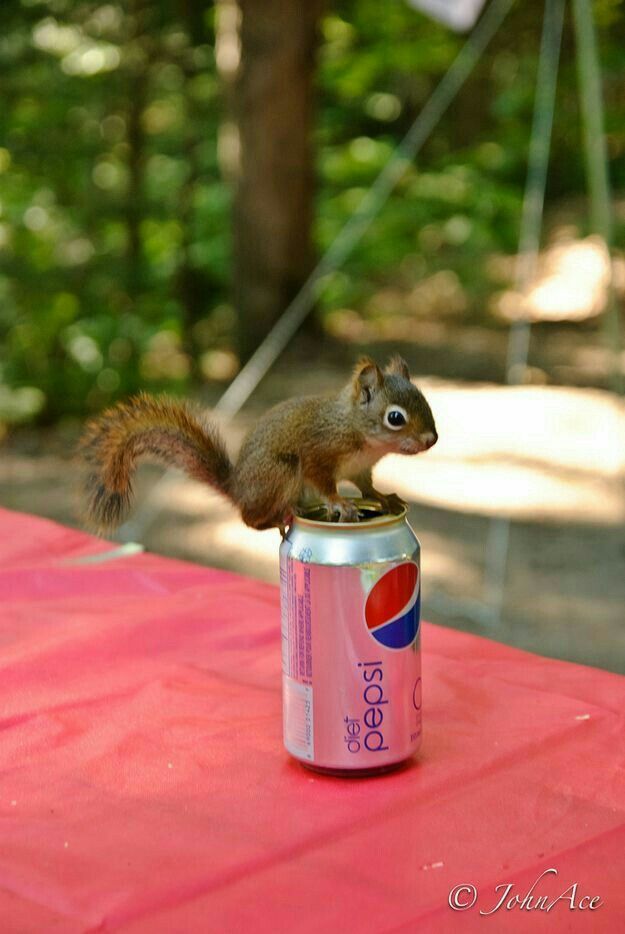 5-17.7 cm.
5-17.7 cm.
At 40 days they try to find food themselves.
They start independent life at two months.
Puberty at 5 months.
If you picked up a baby, it must be warmed, watered and fed. The optimum temperature for a squirrel is 27ºС.
Suitable for feeding: cow's or goat's milk diluted 1:1 with boiled water or milk replacer for kittens. Feed carefully one drop from a pipette so that the baby does not choke. Massage your tummy before and after every feeding.
If the squirrel begins to choke, stop feeding, hold him upside down and wipe his nose and mouth, then continue to feed even more slowly.
Approximate feeding schedule for baby squirrels depending on age:
| Age | Amount of food at one meal | Feeding frequency | Feeding interval |
| 1 day to 14 days | 0. 5 - 2 ml 5 - 2 ml | 6 - 8 times a day | 2 - 3 hours |
| 14 -28 days | 2 - 4 ml | 5-6 times a day | 3 - 4 hours |
| 4-6 weeks | 4 - 6 ml or more | 4 times a day (you can stop feeding at night) | 4 - 5 hours |
| From 6 weeks | 6 - 12 ml | 2-3 times a day | 6 – 12 noon |
From the age of six weeks, squirrels can eat more solid food: white bread soaked in goat's milk. Gradually, “adult” food is included in the diet (at first in crushed form). Milk mixture can be given until the animal itself refuses it.
An adult squirrel is fed twice a day, offering a variety of foods: pine nuts, hazelnuts and walnuts in the shell, acorns, raw pumpkin and sunflower seeds (not fried!), dry and fresh mushrooms, bananas, apples, pears, dried fruits, carrots , white crackers, raspberries, blueberries, blueberries, mountain ash, viburnum, bark, buds, shoots, cones of firs and pines, raw and boiled quail and chicken eggs, egg shells, chalk, charcoal, flour worms, low-fat cottage cheese, butter ( rare and few).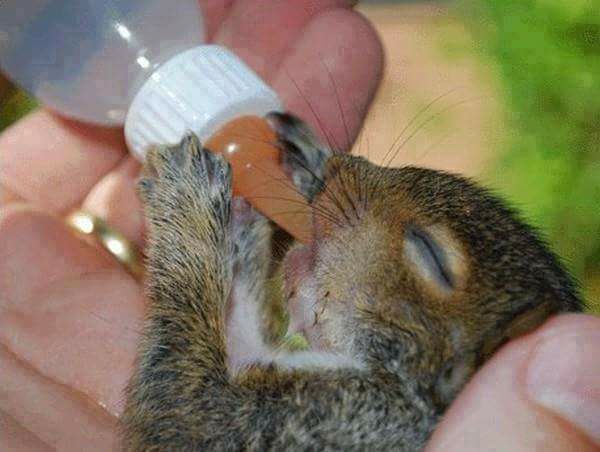
Almonds are poison for squirrels!
Approximate daily ration for a squirrel: 10-15 g of white bread (not rich), 15-20 g of nuts, 20-25 g of fruits and berries (dried fruits in winter).
Extract from the Diet Book:
| No. p/n | Designation | Periodicity of issue | Quantity g/1 head/day |
| 1 | Wheat bread | daily | 10 |
| 2 | Hazelnuts | daily | 10 |
| 3 | Walnuts | two days later | 10 |
| 4 | Pine nuts | daily | 10 |
| 5 | Groundnuts | daily | 10 |
| 6 | Chestnut | every other day | 10 |
| 7 | Sunflower seeds | daily | 10 |
| 8 | Pumpkin seeds | daily | 10 |
| 9 | Apples | every other day | 5 |
| 10 | Carrot | every other day | 5 |
| 11 | Cabbage | every other day | 5 |
| 12 | Fruits, berries | daily | 2 |
| 13 | Dried fruits | daily | 2 |
| 14 | Sugar Cookies | for work | 2 |
| 15 | Hemp | daily | 2 |
| 16 | Dry mushrooms | daily | 2 |
| 17 | Salad | daily | 2 |
| 18 | Curd | daily | 2 |
| 19 | Milk | daily | 3 |
| 20 | Butter | daily | 2 |
| 21 | Chicken egg | every other day | 1 |
| 22 | Honey | alternate | 2 |
| 23 | Jam | alternate | 2 |
| 24 | Salt | daily | 2 |
| 25 | Chalk | alternate | 2 |
| 26 | Bone meal | alternate | 2 |
| 27 | Flour worm | daily | 2 |
| 28 | Fish | daily | 2 |
| 29 | Grass, branches | daily | ad libitum |
| 30 | Cones | daily | ad libitum |
| 31 | Needles | daily | ad libitum |
In winter, for the prevention of beriberi, honey or vitamins A, D, E in oil can be added to food or drink 1 drop per animal 1 time per week.
Do not use boiled or tap water, filtered water or well water will do. Water is changed twice a day. Squirrels willingly drink milk, juices and tea.
All products must be fresh and of good quality.
Do not feed the squirrel spicy, salty, smoked, fried, with spices, etc. Do not abuse sweets.
If possible, an outdoor enclosure should be built for the squirrel. Approximate dimensions are 2x1.5x1.5 m. Three walls are made of a metal mesh with cells of 10-15 mm2. The fourth wall and the roof are made deaf. Along the perimeter, boards are made 10–20 cm high in order to protect the animal from possible pests (cats, dogs, etc.). For ease of cleaning, you need a door that should close well. A snag with branches and wooden shelves are placed inside the enclosure, along which the animal will frolic, and on which it will grind its claws. Also, the squirrel needs a house - shelter. It is necessary to provide building material for home improvement - it can be wool, scraps of fabric, and so on.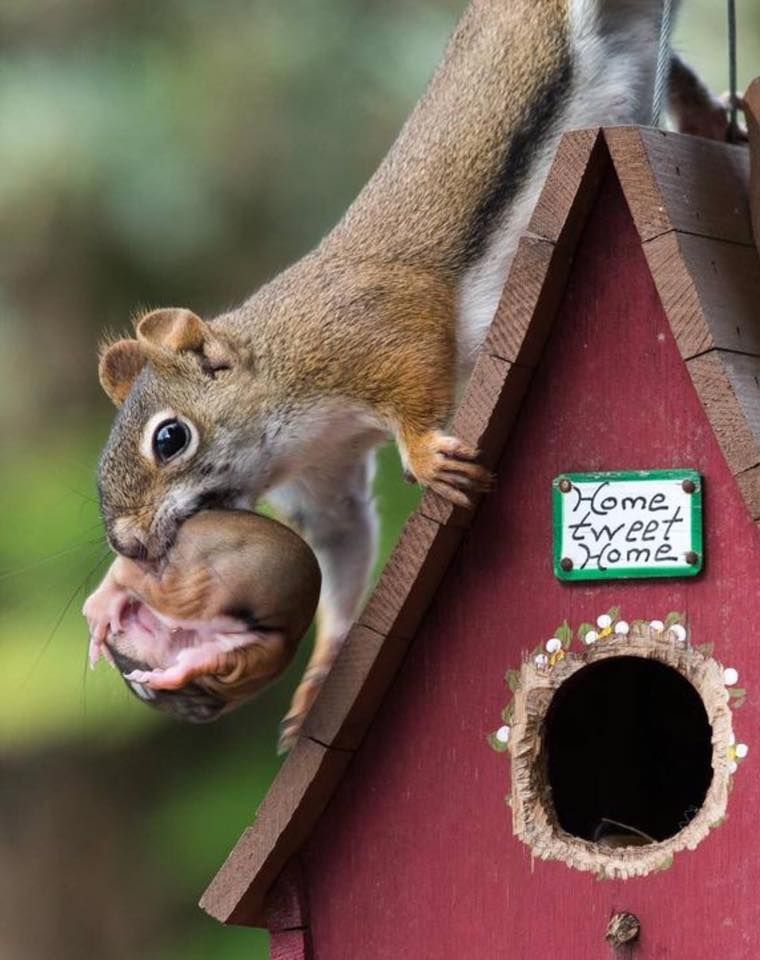
Feeders and drinkers must be securely fastened so that the animal cannot knock them over.
If it is not possible to keep the squirrel in an aviary, you will need a cage with a minimum size of 60x50x50 cm. The frame must be metal, otherwise the squirrel will be able to get free. Outside the cage it is worth equipping the wheel. Wooden shelves and driftwood are placed in the cage, as well as a shelter house and landscaping material.
The cage is placed opposite the window. If the cage is to be moved outside or onto a balcony, a solid roof is required, as squirrels are very sensitive to direct sunlight and are easily subject to sun and heat shock.
In nature, squirrels are more active in the morning and at dusk, but they can also adapt to other modes.
Cleaning should be done 2-3 times a week, but at least once a week. Squirrels are very attached to their smell, so do not use detergents. Frequent cleaning will save you from unpleasant odors. Once a month, it is worth pouring boiling water over all interior items and a cage for disinfection.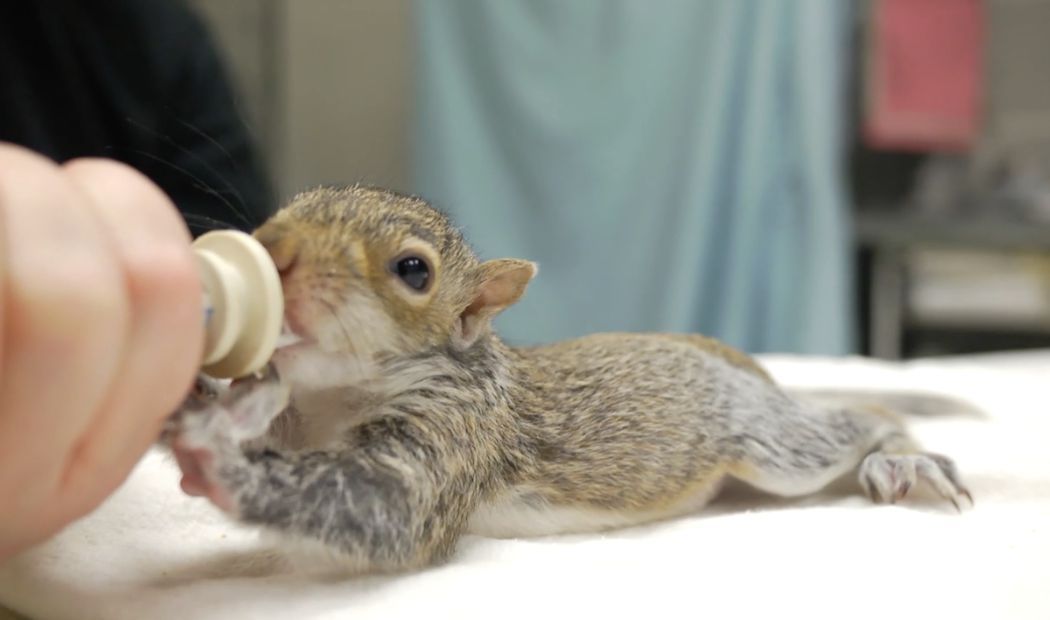
Squirrels molt twice a year: in autumn they change their red summer clothes for gray winter clothes, and vice versa in spring.
The squirrel needs your attention all the time.
If you picked up a squirrel and fed it with a pipette, in the wild it will not be able to feed itself on its own, because it simply does not know how to do it. Such an animal cannot be released into the wild, it will not be able to live without your care.
If you picked up an adult sick squirrel and left it, but it did not become tame, you should think about returning it to nature. It is best to do this in April - May, when the spring rut is over, in order to avoid violence from relatives, and there is still a whole summer ahead and the animal will have time to acquire supplies for the winter. It is necessary to release the squirrel into the wild into the habitual halo of habitat - to where you took it from.
And remember: a squirrel, like any other animal, is a potentially dangerous source of infectious, invasive and parasitic diseases for humans!
Veterinary doctor
For any questions regarding the health of your pets
, you can contact our clinic at:
st.